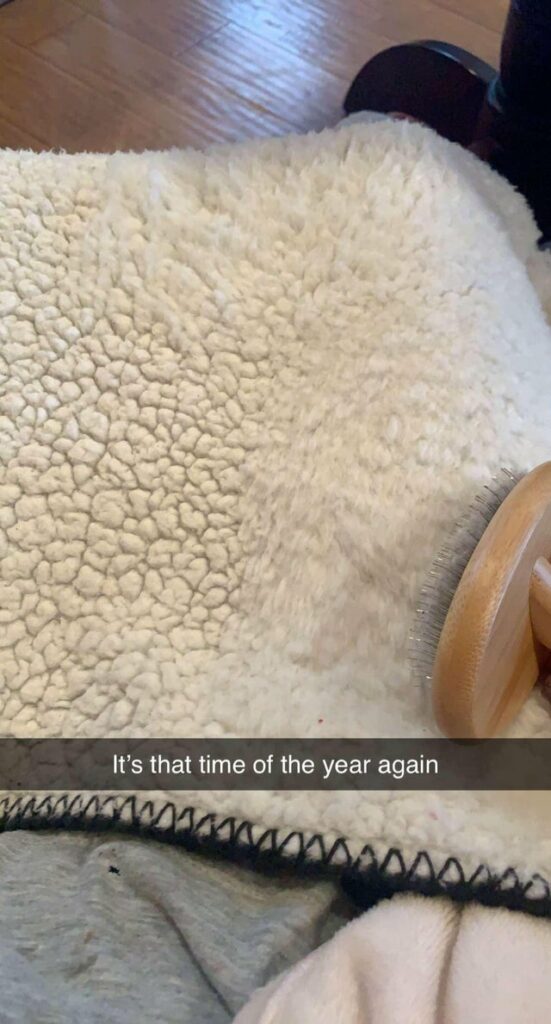Sherpa jackets are amazing. They keep you warm with their fur lining and make you look cool and badass. These jackets have become wardrobe essentials for the fall and winter season by this point.
But they have a small problem.
They get matted.
If you don’t know what matted sherpa is, then consider yourself lucky. Matted sherpa refers to the condition when the inner fur lining of the jacket loses its fluffiness and starts forming “clumps”.
The matting of sherpa makes it very weak and prone to tears and balding. It also ruins the look of the jacket. But lucky for us, fixing matted sherpa is not that difficult. In this guide, I would give you a step-by-step process for fixing this issue.
The method outlined below works on everything made from sherpa and fleece, including but not limited to sherpa jackets, sherpa pullovers, and fleece hoodies. If you follow these 5 steps, you can be certain that your sherpa is going to be back to its original fluffy state.
1. Gather the right materials
The primary way of getting rid of clumps from sherpa garments is by brushing the fibers in such a way that they stop sticking to each other. And of course, if you are going to be brushing, you are going to need a quality brush.
Depending on the severity of the matting, you can go for either a clothes brush (for minimal to small clumps) to a slicker brush (for larger clumps and heavy matting). You can find both of these options for pretty cheap on Amazon.
If you are not sure which one to get, here’s my favorite slicker brush and clothes brush.
You are also going to be needing some fabric softener and a bottle of white vinegar, so make sure that you also get those while ordering your brush. Go for any brand that you like, it doesn’t really make a difference.
2. Clean your sherpa thoroughly
Before the brushing process begins, you need to clean the garment at hand, whether it is a sherpa jacket or pullover. Fleece items also need to be cleaned.
Throw your garment in the washing machine and select the gentle cycle. Make sure that you use cold water because going for hot water can further intensify the matting of your fleece or sherpa.
Instead of detergent add some white vinegar to the wash. The vinegar would help in both cleaning the fibers of sherpa as well as opening it up. This loosening is going to be really beneficial when we get to the brushing stage.
Once the wash cycle is complete, hang dry your garment. Do not throw it into the dryer, because we don’t want it to be completely dry when we get to the brushing stage.
3. Lay the garment on a flat surface and keep it damp
Dry the sherpa until it becomes damp. Remember, we don’t want the fabric to be dripping wet or completely dry.
Lay the garment flat on a table. If it’s a jacket that has a sherpa lining on the inside, then turn the jacket inside out. You can lay your fleece pullovers as is. Basically, we want the sherpa or fleece side on top.
Now take a small spray bottle and add a tablespoon of fabric softener to it. Fill the rest of the bottle with water, and shake it well so that the two materials combine to form a solution.
Use this spray bottle to wet and soften the area that you are going to be brushing.
4. Start brushing in unidirectional strokes

After spraying the fabric softener solution on your target area, it is time to start brushing. Start gently and slowly go deeper and deeper into the roots of the fabric.
Make smooth circular strokes. Go as slow as possible to avoid the fleece fibers from shedding. Don’t pull the brush horizontally or vertically, as that will not completely get rid of the matting. It’s very important that you only go for circular strokes.
And it is even more important that you brush in only one direction. If you are brushing in the clockwise direction, don’t randomly start making anti-clockwise strokes. If you are brushing the sherpa in the anti-clockwise direction, don’t make any weird clockwise strokes.
This will ensure that the now softened and fluffy sherpa fibers only flow in one direction. This will allow them to provide you with more warmth, and it will also look aesthetically pleasing.
But there’s one thing to be aware of before you start – this process takes time. Depending upon the size of your garment it can take anywhere between 30 minutes to 6 hours to completely fix the matted sherpa.
I have tried everything, but there’s no way to get this done in 10 minutes. So you just have to be ready with the time commitment associated with such a project.
5. Use a lint roller to get rid of stuck lint
Once all the matting from your sherpa or fleece garment is gone, it is time to do some final things that will keep the health of your fabric at an all-time high.
When sherpa fibers start matting together, they also attract a tone of unwanted substances into the mix. Therefore, you may notice some excess lint spread across the sherpa fibers now that the clumps that were hiding it are gone.
A cheap lint roller is going to do the trick here, and it is going to make your clothes look like a million bucks. Just get one off of Amazon (here’s my favorite).
- LINT ROLLER: Scotch-Brite Lint Roller, 1 Roller, 95 Sheets
- SCOTCH BRAND ADHESIVE picks up fur, fuzz, pet hair, and debris for a crisp, clean look
- LINT REMOVER works on clothing, furniture, upholstery, and more
- ERGONOMIC HANDLE designed to fit comfortably in your hand
Simply roll it over the entire piece and it will automatically capture any lint or unwanted fluff that resides on the surface of your sherpa.
And voila! You have a completely brand-new-looking sherpa item now.
Here’s a quick summary of the five points mentioned in this guide:
- Gather the right materials.
- Clean your sherpa thoroughly.
- Lay the garment on a flat surface and keep it damp.
- Start brushing in unidirectional strokes.
- Use a lint roller to get rid of stuck lint
NOTE: Always test the fabric softener and the vinegar in a small secluded spot on the sherpa. Doing this spot test will confirm whether the chemicals in these substances harm your clothing or not.

My name is Alex Higson and I am the founder of Magic Of Clothes. I have worked in the fashion industry for many years, and clothes and style are a huge part of my life.



